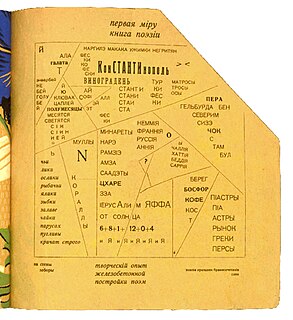 W
WAn acrostic is a poem or other composition in which the first letter of each line spells out a word, message or the alphabet. The word comes from the French acrostiche from post-classical Latin acrostichis, from Koine Greek ἀκροστιχίς, from Ancient Greek ἄκρος "highest, topmost" and στίχος "verse". As a form of constrained writing, an acrostic can be used as a mnemonic device to aid memory retrieval.
 W
WA calligram is text arranged in such a way that it forms a thematically related image. It can be a poem, a phrase, a portion of scripture, or a single word; the visual arrangement can rely on certain use of the typeface, calligraphy or handwriting, for instance along non-parallel and curved text lines, or in shaped paragraphs. The image created by the words illustrates the text by expressing visually what it says, or something closely associated; it can also, on purpose, show something contradictory with the text or otherwise be misleading.
 W
WAugusto de Campos is a Brazilian writer who was a founder of the Concrete poetry movement in Brazil. He is also a translator, music critic and visual artist.
 W
WCarmen figuratum is a poem that has a certain shape or pattern formed either by all the words it contains or just by certain ones therein. An example is France Prešeren's "Zdravljica", where the shape of each stanza resembles a wine cup. The term derives from the carmina figurata of Renaissance texts – works in which a sacred image was picked out in red letters against a field of black type so that a holy figure could be seen and meditated on during the process of reading.
 W
WA chronogram is a sentence or inscription in which specific letters, interpreted as numerals, stand for a particular date when rearranged. The word, meaning "time writing", derives from the Greek words chronos and gramma.
 W
WConcrete poetry is an arrangement of linguistic elements in which the typographical effect is more important in conveying meaning than verbal significance. It is sometimes referred to as visual poetry, a term that has now developed a distinct meaning of its own. Concrete poetry relates more to the visual than to the verbal arts although there is a considerable overlap in the kind of product to which it refers. Historically, however, concrete poetry has developed from a long tradition of shaped or patterned poems in which the words are arranged in such a way as to depict their subject.
 W
WEaster Wings is a poem by George Herbert which was published in his posthumous collection, The Temple (1633). It was originally formatted sideways on facing pages and is in the tradition of shaped poems that goes back to ancient Greek sources.
 W
WAnna Thilda May "May" Swenson was an American poet and playwright. Harold Bloom considered her one of the most important and original poets of the 20th century.